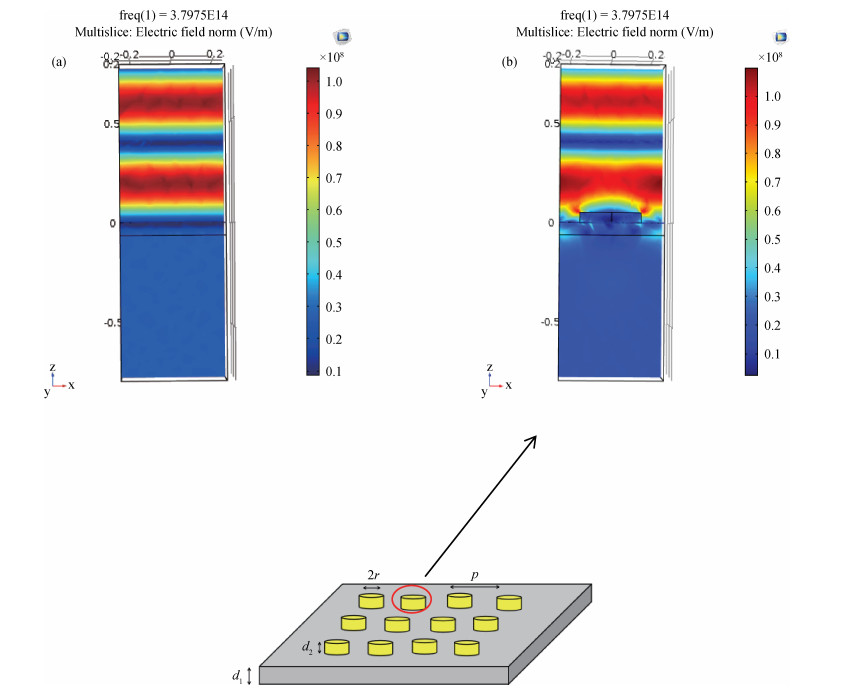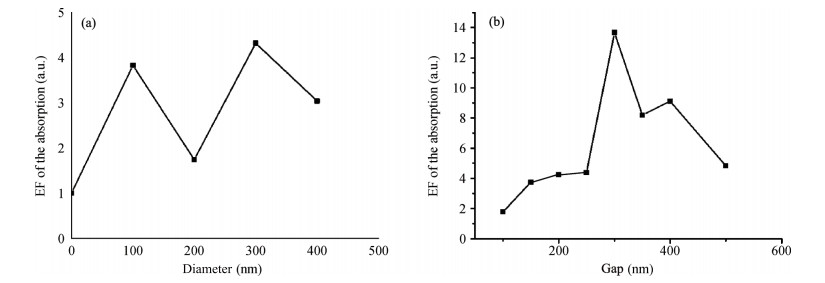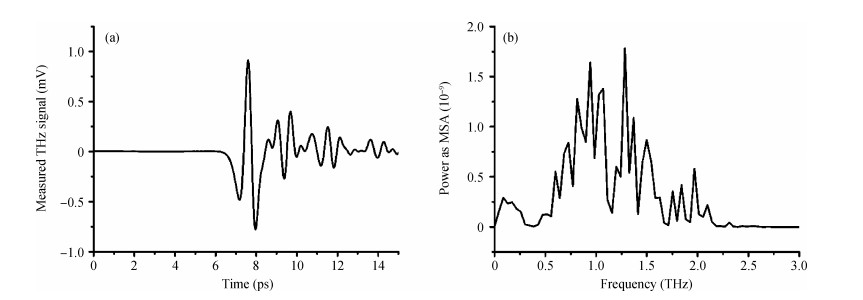| Citation: |
Zhiguang Ao, Jinhai Sun, He Cai, Guofeng Song, Jiakun Song, Yuzhi Song, Yun Xu. Nanoplasmonic-gold-cylinder-array-enhanced terahertz source[J]. Journal of Semiconductors, 2016, 37(12): 123002. doi: 10.1088/1674-4926/37/12/123002
****
Z G Ao, J H Sun, H Cai, G F Song, J K Song, Y Z Song, Y Xu. Nanoplasmonic-gold-cylinder-array-enhanced terahertz source[J]. J. Semicond., 2016, 37(12): 123002. doi: 10.1088/1674-4926/37/12/123002.
|
Nanoplasmonic-gold-cylinder-array-enhanced terahertz source
DOI: 10.1088/1674-4926/37/12/123002
More Information
-
Abstract
Photoconductive antennas (PCAs) based on nanoplasmonic gratings contact electrodes have been proposed to satisfy the demand for high power, efficiency and responsivity terahertz (THz) sources. Reducing the average photo-generated carrier transport path to the photoconductor contact electrodes was previously considered the dominant mechanism to improve PCAs' power. However, considering the bias in a real device, the electric field between gratings is limited and the role of surface plasmonic resonance (SPR) field enhancement is more important in improving THz radiation. This paper, based on SPR, analyzes the interaction between incident light and substrate in nano cylinder array PCAs and clearly shows that the SPR can enhance the light absorption in the substrate. After the optimization of the structure size, the proposed structure can offer 87% optical transmission into GaAs substrate. Compared with conventional PCAs, the optical transmission into the substrate will increase 5.8 times and the enhancement factor of substrate absorption will reach 13.7 respectively. -
References
[1] Tonouchi M. Cutting-edge terahertz technology. Nat Photon, 2007, 1: 97 doi: 10.1038/nphoton.2007.3[2] Ferguson B, Zhang X C. Materials for terahertz science and technology. Nat Mater, 2002, 1: 26 doi: 10.1038/nmat708[3] Hu B B, Nuss M C. Imaging with terahertz waves. Opt Lett, 1995, 20: 1716 doi: 10.1364/OL.20.001716[4] Han S P, Ko H, Kim N, et al. Real-time continuous-wave terahertz line scanner based on 1×240 InGaAs Schottky barrier diode array detector. Opt Express, 2014, 22: 28977 doi: 10.1364/OE.22.028977[5] Moon K, Kim N, Shin J H, et al. Continuous-wave terahertz system based on a dual-mode laser for real-time non-contact measurement of thickness and conductivity. Opt Express. 2014, 22: 2259 doi: 10.1364/OE.22.002259[6] Lee I M, Kim N, Lee E S, et al. Frequency modulation based continuous-wave terahertz homodyne system. Opt Express, 2015, 23: 846 doi: 10.1364/OE.23.000846[7] Pickwell E, Wallace V P. Biomedical applications of terahertz technology. J Phys D, 2006, 39: R301 doi: 10.1088/0022-3727/39/17/R01[8] Federici J F, Schulkin B, Huang F, et al. THz imaging and sensing for security applications-explosives, weapons and drugs. Semicond Sci Technol, 2005, 20: S266 doi: 10.1088/0268-1242/20/7/018[9] Rodriguez G, Caceres S R, Taylor A J. Modeling of terahertz radiation from biased photoconductors: transient velocity effects. Opt Lett, 1994, 19: 1994 doi: 10.1364/OL.19.001994[10] Rodriguez G, Taylor A J. Screening of the bias field in terahertz generation from photoconductors. Opt Lett, 1996, 21: 1046 doi: 10.1364/OL.21.001046[11] Jepsen P U, Jacobsen R H, Keiding S R. Generation and detection of terahertz pulses from biased semiconductor antennas. J Opt Soc Am B, 1996, 13: 2424 doi: 10.1364/JOSAB.13.002424[12] Heshmat B, Pahlevaninezhad H, Pang Y, et al. Nanoplasmonic terahertz photoconductive switch on GaAs. Nano Lett, 2012, 12: 6255 doi: 10.1021/nl303314a[13] Park S G, Jin K H, Yi M, et al. Enhancement of terahertz pulse emission by optical nanoantenna. ACS Nano, 2012, 6: 2026 doi: 10.1021/nn204542x[14] Berry C W, Wang N, Hashemi M R, et al. Significant performance enhancement in photoconductive terahertz optoelectronics by incorporating plasmonic contact electrodes. Nat Comm, 2013, 4: 1622 doi: 10.1038/ncomms2638[15] Yang S H, Hashemi M R, Berry C W, et al. 7.5% optical-to-terahertz conversion efficiency offered by photoconductive emitters with three-dimensional plasmonic contact electrodes. IEEE Trans Terahertz Sci Technol, 2014, 4: 575 doi: 10.1109/TTHZ.2014.2342505[16] Jooshesh A, Smith L, Masnadi-Shirazi M, et al. Nanoplasmonics enhanced terahertz sources. Opt Express, 2014, 22: 27992 doi: 10.1364/OE.22.027992[17] Berry C W, Jarrahi M. Terahertz generation using plasmonic photoconductive gratings. New J Phys, 2012, 14(10): 105029 doi: 10.1088/1367-2630/14/10/105029[18] Moon K, Lee I M, Shin J H, et al. Bias field tailored plasmonic nanoelectrode for high-power terahertz photonic devices. Sci Rep, 2015, 5: 13817 doi: 10.1038/srep13817[19] Burford N, El-Shenawee M. Computational modeling of plasmonic thin-film terahertz photoconductive antennas. J Opt Soc America B, 2016, 33(4): 748 doi: 10.1364/JOSAB.33.000748[20] Lee Y S, Lee Y S, Lee Y S, et al. Principles of terahertz science and technology. Berlin: Springer, 2009[21] Ebbesen T W, Lezec H J, Ghaemi H F, et al. Extraordinary optical transmission through sub-wavelength hole arrays. Nature, 1998, 391(6668): 667 doi: 10.1038/35570[22] Fang Z, Lin C, Ma R, et al. Planar plasmonic focusing and optical transport using CdS nanoribbon. Acs Nano, 2010, 4(1): 75 doi: 10.1021/nn900729n[23] Bao Yanjun, Hu Zhijian, Li Ziwei, et al. Magnetic plasmonic Fano resonance at optical frequency. Small, 2015, 11(18): 2177 doi: 10.1002/smll.v11.18[24] Kim T J, Thio T, Ebbesen T W, et al. Control of optical transmission through metals perforated with subwavelength hole arrays. Opt Lett, 1999, 24(4): 256 doi: 10.1364/OL.24.000256[25] Shen Y C, Upadhya P C, Linfield E H, et al. Ultrabroadband terahertz radiation from low-temperature-grown GaAs photoconductive emitters. Appl Phys Lett, 2003, 83(15): 3117 doi: 10.1063/1.1619223[26] Palik E D. Handbook of optical constants of solids. Part II. Academic Press, 1985, 33(1): 189[27] Adachi S. Optical constants of crystalline and amorphous semiconductors. Material Und Organismen, 1998, 88(4): 953 http://link.springer.com/content/pdf/bfm%3A978-1-4615-5247-5%2F1.pdf[28] Rubén D V R, Bikorimana S, Ummy M A, et al. A bow-tie photoconductive antenna using a low-temperature-grown GaAs thin-film on a silicon substrate for terahertz wave generation and detection. J Opt, 2015, 17(12): 167 https://www.researchgate.net/publication/283671046_A_bow-tie_photoconductive_antenna_using_a_low-temperature-grown_GaAs_thin-film_on_a_silicon_substrate_for_terahertz_wave_generation_and_detection -
Proportional views






 DownLoad:
DownLoad:




















